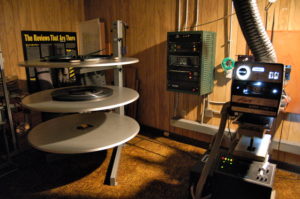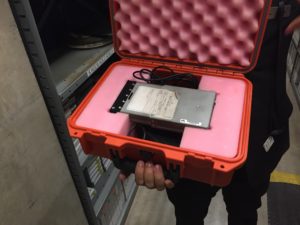So, the other day I was scrolling through the offerings at my local AMC theater, considering which movie to use of my reservations for and as I saw a number of films that had but one or two screenings for the entire day I suddenly considered the changing technology and options of film exhibition.
Many moons ago I worked at a local theater as an usher. It was a multiplex and each screen showed the same film throughout the week and, except for the rare double bill, only one film screen in each auditorium. Once a feature no longer commanded enough people in seats to justify the screen space it occupied all week the film was broken down back into its component reels and shipped away. This is very different than today where a film, such asThe Upside might play for a showing or two during the matinee hours and then a different movie take over the screen for the prime time evening audience and it all comes down to digital technology.
This is the projector and film platter for a traditional projection booth. That massive set of three platters hold the entire film that had been assembled from its individual reels. At the theater where I worked this was done by an assistance manager for an extra $75
dollars per week. When Romero’s Day of the Dead was released my friend, who was one of the assistant managers, assembled the print and we stayed later to ‘test’ it, screening the disappointing film for ourselves. Assembling the print onto the platter was a laborious and time consuming processes which dictated that you did not change out prints often or easily.
Here is the sort of hard drive that modern digital prints are distributed on these days. I took this photo during my tour of Paramount Studios and this has quickly become the standard for motion picture exhibition. It’s a lot cheaper to ship that hard drive than the reels and reels of a lengthy feature film, it involves a lot fewer employee hours to set up and project, and it is free from tampering my mischievous theater owners or employees. (I once worked for a theater manager who privately admitted to ‘editing’
the end of a film and sending it back out for distribution.) These hard drives are not only loaded with the film ‘assembled’ and ready to exhibit but also with a digital count that has been pre-authorized. The theaters can project the feature only as many times as authorized and no more. If a theater wants to hold a film over for more showing they have to contact the studio or distributor to have the hard drive reauthorized. (No more private screens like my friend and I enjoyed.) I suspect that these one a day showing of films that have been in release for months may be the theaters using every authorized screening before returning the drive back to the studio.
There are those who love film and maintain it has a look that digital has not duplicated but the chance for films to find audiences and for people to catch screening of movies that had missed I think is a wonderful thing.


